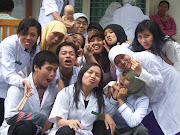
Basic Theory Liver Abcess
Two category : Amebic and pyogenic. Amebic liver abcess (commonly because Entamoeba histolytica), common cause on tropic or developing country.
Pathopysiology
Whenever an infection develops anywhere along the biliary of GI tract, infecting organism may reach the liver through the biliary system, portal venous system, or hepatic arterial or lymphatic system. The bacterial toxins destroy the neighboring liver cells, and resulting necrotic tissue serves as a protective wall for the organism.
Meanwhile, leucocytes migrate into infected area. Make abcess cavity full of a liquid, dead leucocytes and liver cell and bacteria. Pyogenic abcess of this type may be single, multiple and small. Examples of causes of pyogenic liver abcess include cholangitis and abdominal trauma.
Clinical manifestation
Fever with chills and diaphoresis, malaise, anorexia, nausea, vomiting, and weight loss may occur. Complaint dull abdominal pain and tenderness in the right upper quadrant abdomen. Hepatomegaly, jaundice, anemia, pleural effusion may develop. Sepsis and shock may be severe and life threatening.
Assessment and diagnostic finding
Blood culture are obtained but may not identify the organism. Aspiration of liver abcess guided US or CT scan, may be performed to assist in diagnosis and to obtain cultures of the organism. Percutaneous drainage of pyogenic abcess is carried out to evacuate abcess material and promote healing, with a catheter may be left in place for continues drainage.
Medical Management
Antibiotic iv therapy, the specific antibiotic use in treatment depends on the organism identified. Open surgical drainage may be required if antibiotic therapy and percutaneous drainage are ineffective.
NURSING CARE PLAN
Nursing Diagnoses :
1. Abdominal pain; discomfort R/T inserted liver drainage, process of diseases
2. Increased body temperature : hyperthermia, fever R/T infectious, presented abcess
3. Altered nutrition : less than body requirements R/T nausea, vomit, inadequate intake
4. Risk impaired skin integrity R/T inserted liver drainage tube
5. Potential Infectious large; septic R/T Inaddequate therapy, weakness
6. Anxiety R/T knowledge deficit about diseases and management therapy
Nursing objective :
1. Reduce pain : able torest, no complaint of pain and discomfort
2. Reduce fever : T normal
3 Provide adequate nutrition : adequate body weight, no vomit, Albumin normal
4. No inflammation on drainage area, sign of redness, adequate fixations
5. Healing of infectious, no signs septic, reduce : abcess drainage
6. No anxiety, ptn able to understands medication, management therapy and follow up treatment
Nursing Intervention
1. Abdominal pain; discomfort R/T inserted liver drainage, process of diseases
A. Asses and checked signs and complaint of pain
B. Suggested deeph breathing exercise and distraction technique
C. Apply compress on pain area
D. Suggest patients to take little food but frequent
E. Administered soft diet, low residu, and hepatic diet
C. Administered pain killer, analgesic as order
F. Administered antacid, zantac as order
2. Increased body temperature : hyperthermia, fever R/T infectious, presented abcess
A. Observed vital signs, monitor Temperature
B. Apply cold compress on axilla if fever
C. Administered antipiretic : panadol as order
D. Suggested increase oral intake
E. Administered IVF as order
F. Apply thick cloth or thick blanket
G. Sent all c/s screening as order
Altered nutrition : less than body requirements R/T nausea, vomit, inadequate intake, loss appetite
A. Asses frequent, appetite, type of diet or eating patient
B Assist ptn and encourage him to take food
C. Suggested ptn take diet frequently, little amount
D. Observed signs of vomit, nausea
F. Administered IVF as order
G. Measure body weight
H. Monitor lab : albumin, cholesterol
I. Administered anti emetic as order
4. Risk impaired skin integrity R/T inserted liver drainage tube
A. Observed patent of liver drainage
B. Observed signs redness, warm, or drainage condition on area of liver drainage
C. Do dressing with sterile technique daily with betadine and NS
D. Suggested ptn carefully during handling the liver tube, dont put bag more higher than abdomen area, do clamp as necessary
E. Daily changed clothe and linen
F. Suggested ptn not to removed or touch drain area
5. Potential Infectious large; septic R/T Inaddequate therapy, weakness
A. Observed and monitor output and condition of liver abcess drainage
B. Sent all diagnostic blood : CBC, ESR, blood c/s, liver abcess c/s, gram strain, differential etc
C. Administered antibiotic as order
D. Suggested ptn to follow up therapy
E. Informed diagnostic procedure ; U/S, blood report and drainage condition
F. Encourage high calorie high protein diet
6. Anxiety R/T knowledge deficit about diseases and management therapy
A. Assess patient knowledge about cause, prognosis, medication and treatment of diseases
B. Checked and assess signs of anxiety, un able to sleep
C. Explain about patient condition, cause, prognosis, management and supportive therapy
D. Suggested ptn to avoid alcohol drugs induced hepatotoksid
E. Explain that drainage will be d/c after less puss or drain and only temporary
F. To take all antibiotic as order
G. To prevent eat, drink from good source |




1 komentar:
"Loved reading this, great insights!"
Iv therapy near me in Lake Elsinore
Posting Komentar